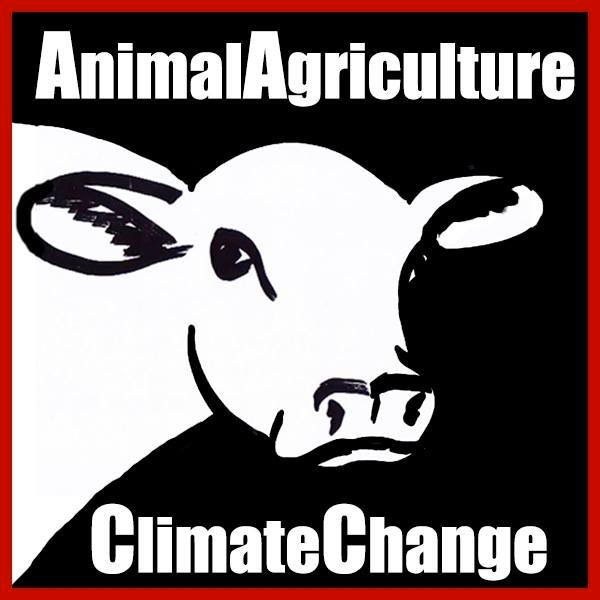Researchers Robert Goodland and Jeff Anhang find that animal agriculture contributes more to climate change than any other factor.
Robert Goodland and Jeff Anhang are co-authors of “Livestock and Climate Change”, an assessment of the true environmental impact animal agriculture in our food system has. The amount of greenhouse gases or GHG’s attributed to animal agriculture has been drastically underestimated as their report shows.
Typically the percentage of annual GHG’s from animal agriculture is cited at 18{85424e366b324f7465dc80d56c21055464082cc00b76c51558805a981c8fcd63} per year. That comes from a 2006 report from the United Nations Food and Agriculture Organisation or the FAO for short. Their report “ Livestock’s Long Shadow” misses the mark because it doesn’t take into account the animal’s respiration release of GHG’s and leaves out animals like fish on fish farms. The true number is 51{85424e366b324f7465dc80d56c21055464082cc00b76c51558805a981c8fcd63} per year or 32.6 billion tons of carbon dioxide per year being released into the Earth’s atmosphere. That’s more than trains, planes, and automobiles combined annual pollution many times over.
Highlights of Robert Goodland and Jeff Anhang’s Report include:
- Overlooked – the inclusion of respiration more than doubles livestock’s annual GHGs.
- Overlooked – the FAO only includes the change in land use and deforestation which is relatively small compared to the land already in use for livestock production. Significant GHG reductions from photosynthesis are foregone by using 26{85424e366b324f7465dc80d56c21055464082cc00b76c51558805a981c8fcd63} of land for grazing and 33{85424e366b324f7465dc80d56c21055464082cc00b76c51558805a981c8fcd63} of arable land for growing feed.
- Underestimated – methane has a much shorter half-life (8 years) than CO (100 years). The FAO and others have considered methane to be 21-25x stronger than CO2 by using a 100-year time-frame. The International Panel on Climate Change recommends using a 20-year time-frame instead, thus increasing methane’s global warming potential (GWP) to 72. The short half-life and high GWP means that methane reductions have a faster impact on climate change than CO2 reductions. Goodland and Anhang use the FAO’s 37{85424e366b324f7465dc80d56c21055464082cc00b76c51558805a981c8fcd63} for their methane calculation and increase the total GHG to accommodate the increased GHG. The authors note that additional research is needed to increase the world’s total GHG level from non-livestock sources of methane.
- Underestimated – the FAO uses dated statistics from 2002 and earlier. Livestock alone has increased by 12{85424e366b324f7465dc80d56c21055464082cc00b76c51558805a981c8fcd63} since 2002.
- Underestimated – the FAO decreased official livestock counts by more than half (for example using 33 million tonnes for poultry instead of their own Food Outlook report of 72.9).
- Misallocated – excludes livestock deforestation in Argentina (and other places).
- Misallocated – excludes farmed fish (for feed and direct human consumption).
Uncounted, Overlooked, and Misallocated Livestock Related GHG Emissions
| Annual GHG emissions (CO2e), million tonnes | Percentage of worldwide total |
|
| FAO estimate | 7,516 | 11.8* |
| Uncounted in current GHG inventories | ||
| 1. Overlooked respiration by livestock | 8,769 | 13.7 |
| 2. Overlooked land use | 2,672 | 4.2 |
| 3. Undercounted methane | 5,047 | 7.9 |
| 4. Other four categories (see text) | 5,560 | 8.7 |
| Subtotal | 22,048 | 34.5 |
| Misallocated in current GHG inventories | ||
| 5. Three categories (see text) | 3,000 | 4.7 |
| Total GHGs attributable to livestock products | 32,564 | 51.0 |
Further reading: https://mitpress.mit.edu/books/harvesting-biosphere
How much does animal agriculture contribute to climate change?
The commonly quoted percentage of 18{85424e366b324f7465dc80d56c21055464082cc00b76c51558805a981c8fcd63} is incorrect as it doesn’t take many other animals and factors like animal respiration into account. The true number is Animal Agriculture is 51{85424e366b324f7465dc80d56c21055464082cc00b76c51558805a981c8fcd63} of climate change greenhouse gases.
What percent of greenhouse gases come from animal agriculture?
The commonly quoted percentage of 18{85424e366b324f7465dc80d56c21055464082cc00b76c51558805a981c8fcd63} is incorrect as it doesn’t take many other animals and factors like animal respiration into account. The true number is Animal Agriculture is 51{85424e366b324f7465dc80d56c21055464082cc00b76c51558805a981c8fcd63} of climate change greenhouse gases.
What is the largest contributor to climate change?
Animal agriculture is the number one contributor to climate change. 51{85424e366b324f7465dc80d56c21055464082cc00b76c51558805a981c8fcd63} of all Greenhouse gas emissions are from animal agriculture.
How bad is animal agriculture for the environment?
Livestock farming has a vast environmental footprint. It contributes to land and water degradation, biodiversity loss, acid rain, coral reef degeneration and deforestation. Nowhere is this impact more apparent than climate change – livestock farming contributes 51{85424e366b324f7465dc80d56c21055464082cc00b76c51558805a981c8fcd63} of human-produced greenhouse gas emissions worldwide.
What is the number one cause of global warming?
Animal agriculture is the number one contributor to climate change. 51{85424e366b324f7465dc80d56c21055464082cc00b76c51558805a981c8fcd63} of all Greenhouse gas emissions are from animal agriculture.
Original source: https://vegannewsnow.com

